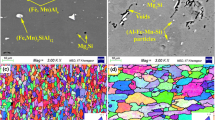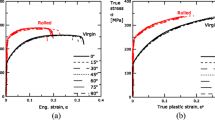Abstract
Warm forming has some important advantages, the most significant being that forming limit strains increase at elevated temperatures. To quantify this advantage for an AA3003 brazing sheet, forming limit diagrams were determined using warm tooling developed to perform limiting dome height (LDH) experiments together with a digital image correlation (DIC) system used to perform in situ strain measurement. Forming limit curves (FLCs) were developed at several temperature levels and strain-rates. The formability experiments demonstrated that while temperature has a significant effect on formability, forming speed has a mild effect within the studied range. Elevating the temperature to 250 °C improved the formability more than 200 % compared to room temperature forming while forming at lower speeds increased the limiting strains by 10 % and 17 % at room temperature and 250 °C, respectively. A comparison between FLDs developed using DIC methods versus circle grid (CG) analysis showed good agreement between the two methods; however, the degree of scatter in the CG method increased significantly for the higher temperature tests.





















Similar content being viewed by others
References
Abedrabboa N, Pourboghrat F, Carsley J (2006) Forming of aluminum alloys at elevated temperatures – part 2: numerical modeling and experimental verification. Int J Plast 22(2):342–373
Abu‐Farha F (2011) The development of a forming limit surface for 5083 aluminum alloy sheet. JOM 63(11):72–78
Ayres RA, Brewer EG, Holland SW (1979) Trans SAE 88(1979):2630–2634
Azrin M, Backofen W (1970) Metal Trans 1(1970):2857
Bagheriasl R, Ghavam K, Worswick MJ (2012) Formability improvement with independent die and punch temperature control. Int J Mater Form. doi:10.1007/s12289-012-1115-6
Bay BK (1995) Texture correlation—a method for the measurement of detailed strain distributions within trabecular bone. J Orthop Res 13:258–267
Bragard A (1989) Forming limit diagrams: concepts, methods, and applications. TMS, Warrendale, pp 9–19
Chen DJ, Chiang FP, Tan YS, Don HS (1993) Digital speckle-displacement measurement using a complex spectrum method. Appl Opt 32:1839–1849
Chu TC et al (1985) Applications of digital-image-correlation techniques to experimental mechanics. Exp Mech 25:232–244
Dinda S, James KF, Keeler SP, Stine PA (1981) How to use circle grid analysis for die tryout. ASM, Metals Park
Ghosh AK (1975) The effect of lateral drawing- in on stretch formability. Metals Eng Q 15(3):53–64
Garcia D, Orteu JJ, Penazzi L (2002) A combined temporal tracking and stereo-correlation technique for accurate measurement of 3D displacements: application to sheet metal forming. J Mater Process Technol 125:736–742
Goodwin GM (1968) Application of strain analysis to sheet metal forming problems in the press shop. Trans Soc Autom Eng 77(1968):380–387
Ghosh AK, Hecker SS (1971) Metall Trans 5(1974):2161
Harvey DN (1984) Optimizing patterns and computational algorithms for automatic, optical strain measurement in sheet metal, efficiency in sheet metal forming. In: Proceedings of the 13th Biennial Congress. International Deep Drawing Research Group, Melbourne, pp 403–414
Hecker SS, Gosh AK, Gegel HL (1978) Formability: analysis, modeling, and experimentation. AIME, New York, pp 150–182
Helm JD, McNeil SR, Sutton MA (1996) Improved three-dimensional image correlation for surface displacement measurement. Opt Eng 35:1911–1920
ISO 12004–1:2008 Metallic materials – sheet and strip – determination of forming-limit curves – part 1: measurement and application of forming-limit diagrams in the press shop
Kapij MI, Lee D (1990) Tribological factors in the stamping of coated and uncoated steel sheets, 16th Biennal Congress of the IDDRG, Borlänge
Kaya S, Giovanni Spampinato G, Altan T (2008) An experimental study on non-isothermal deep drawing process using aluminum and magnesium alloys. J Manuf Sci Eng Trans ASME 130 DOI: 10.1115/1.2975228
Keeler SP, Backofen WA (1963) Plastic instability and fracture in sheets stretched over rigid punches. Trans ASM 56(1963):25–48
Kleemola HJ, Kumpulainen JO (1980) Factors influencing the forming limit diagram: part I: the experimental determination of the forming limits of sheet steel. J Mech Working Tech 3(1980):289–302
Li D, Ghosh A (2004) Biaxial warm forming behaior of aluminum sheet alloys. J Mater Process Technol 145:281–293
Luo PF et al (1993) Accurate measurement of three-dimensional displacement in deformable bodies using computer vision. Exp Mech 33:123–132
McKinley J (2010) Warm forming of aluminum alloy sheet, MASc Thesis, University of Waterloo
Nakazima K, Kikuma T, Hasuka K (1968) Technical report 264. Yawata Iron & Steel Co. Sep 1968, P.141
North American Deep Drawing Research Group (1987) Recommended referee practice for the limiting dome height (LDH) test (1987 October 27)
Peters WH, Ranson WF (1981) Digital imaging techniques in experimental stress analysis. Opt Eng 21:427–431
Pitter MC et al (2002) Focus errors and their correction in microscopic deformation analysis using correlation. Opt Eng 23:1361–1367
Rees DWA (2001) Factors influencing the FLD of automotive sheet metal, J Mater Process Technol 118(1–3):1–8 Accessed 3 Dec 2001
Shi XQ et al (2004) In-situ micro-digital image speckle correlation technique for characterization of materials’ properties and verification of numerical models. IEEE Trans Compon Packag Technol 27:659–667
Sjodahl M, Benckert LR (1993) Electronic speckle photography: analysis of an algorithm giving the displacement with subpixel accuracy. Appl Opt 32:2278–2284
Story JM (1982) Variables affecting dome test results. J Appl Met Work 2(1982):119–125
Sun ZL, Lyons JS, McNeill SR (1997) Measuring microscopic deformations with digital image correlation. Opt Lasers Eng 27:409–428
Stoughton TB (2000) A general forming limit criterion for sheet metal forming. Int J Mech Sci 42(2000):1–27
Sutton MA, McNeill SR, Helm JD, Chao YJ (2000) Advances in two-dimensional and three-dimensional computer vision. In: Rastogi PK (ed) Topics in applied physics, vol 77. Springer, Berlin, pp 323–372
Veerman CC, Hartman L, Peels JJ, Neve PF (1971) Sheet Met Ind 48(1971):678
Vegter H, Dane CM (1985) Proc. 15th Bienn. Congr. IDDRG, Amsterdam
Vogel JH, Lee D (1989) J Mater Shaping Technol 6(1989):205–216
Zhang D, Zhang X, Cheng G (1999) Compression strain measurement by digital speckle correction. Exp Mech 39:62–65
Acknowledgments
Financial support for this research from Dana Canada Corporation-Power Technologies Group, the Natural Sciences and Engineering Research Council of Canada (NSERC) and the Ontario Research Fund is gratefully acknowledged.
Author information
Authors and Affiliations
Corresponding author
Rights and permissions
About this article
Cite this article
Bagheriasl, R., Worswick, M.J. Formability of AA3003 brazing sheet at elevated temperatures: limiting dome height experiments and determination of forming limit diagrams. Int J Mater Form 8, 229–244 (2015). https://doi.org/10.1007/s12289-014-1162-2
Received:
Accepted:
Published:
Issue Date:
DOI: https://doi.org/10.1007/s12289-014-1162-2




